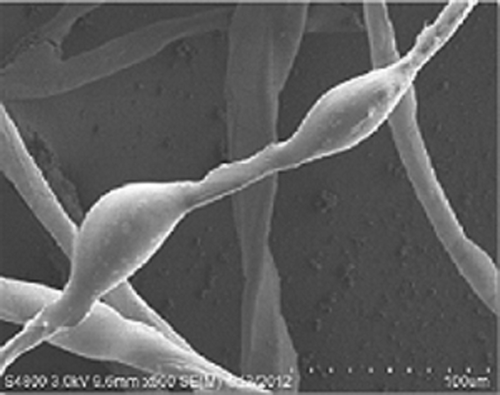With the Deepwater Horizon disaster emphasizing the need for better ways of cleaning up oil spills, scientists are reporting that unprocessed, raw cotton may be an ideal, ecologically friendly answer, with an amazing ability to sop up oil. Their report, which includes some of the first scientific data on unprocessed, raw cotton's use in crude oil spills, appears in the ACS journal Industrial & Engineering Chemistry Research.
Seshadri Ramkumar and colleagues note that a particular need exists for oil-spill sorbents that are abundantly available at relatively low cost, sustainable and biodegradable. There have been extensive studies on fibers such as barley straw, kapok and wool—but big gaps in knowledge about their basic crude oil-uptake mechanisms and no data on unprocessed raw cotton. Ramkumar's team decided to fill those gaps with research on the oil sorption properties of low micronaire cotton, a form of unprocessed cotton with relatively less commercial value.
They report that each pound of the material has the ability to sop up and hold more than 30 pounds of crude oil. The cotton fibers take up oil in multiple ways, including both absorption and adsorption (in which oil sticks to the outer surface of the cotton fiber). "In contrast to synthetic sorbents, raw cotton with its high crude oil sorption capacity and positive environmental footprint make it an ecologically friendly sorbent for oil spill cleanups," the report concludes.
More information: "Crude Oil Sorption by Raw Cotton" Ind. Eng. Chem. Res., 2013, 52 (18), pp 6277–6281. DOI: 10.1021/ie4005942
Abstract
Since the recent Deepwater Horizon Gulf of Mexico oil spill, the need for environmentally friendly oil sorbents has intensified. This study deals with the sorption of crude oil by raw cotton, a biodegradable sorbent. To our best knowledge, the data related to crude oil sorption by unprocessed raw cotton and correlation with cotton characteristics such as micronaire, fineness, and maturity are unavailable. More importantly, our work quantifies the oil sorption (g/g) of low micronaire (immature) cotton. Results showed at the minimum level, low micronaire raw cotton has 30.5 g/g crude oil sorption capacity. Furthermore, the crude oil sorption capacity of low micronaire cotton was significantly higher than the sorption capacity of high micronaire cotton. Brunauer–Emmett–Teller (BET) surface area and environmental scanning electron microscopy analyses support the correlation between the quality characteristics of raw cotton and its oil sorption capacity. In contrast to synthetic sorbents, raw cotton with its high crude oil sorption capacity and positive environmental footprint make it an ecologically friendly sorbent for oil spill cleanups.
Journal information: Industrial & Engineering Chemistry Research
Provided by American Chemical Society




















